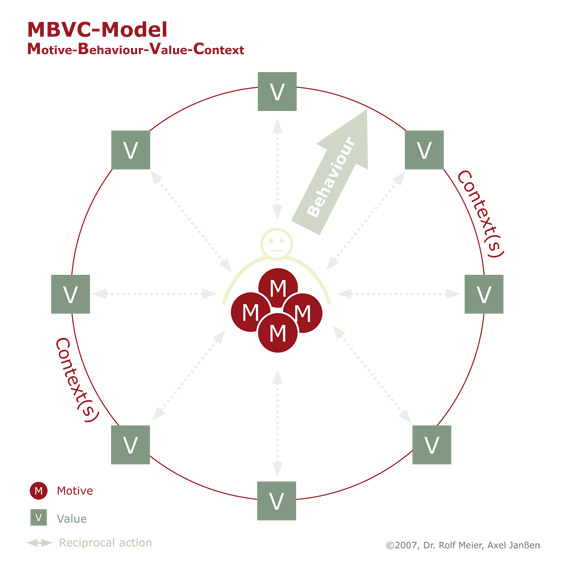MBVC Model
The MBVC model describes the connection between motives, behaviour
and values in a context or contexts. It can equally be used for analysis,
for understanding, for the derivation of reflection and as an offer
for working on the coaching topic.

Within a context, a behaviour is initiated by motives. The behaviour
is oriented towards those values that an individual considers to
be attractive in this context.
Likewise, the existing values in context influence the attractiveness
of the context for the individual. Motivation only occurs when a
context has a certain level of attractiveness for the individual
who subjectively ensures that the motives are allowed to “unfold”.
As one of the elementary models of the Hamburger Schule, the MBVC
model – embedded in axiomatic – is used for various abstractions:

This graphic demonstrates that each individual has a (subjective)
perception of a context. In the best case, behaviour is based upon
common values. Values, which are diametrically in opposition to value
conflicts.
In the graphic itself, the approaches to solutions are already fixed. Thus
the MBVC model can be used within areas such as “conflicts”, “fusion”, “intercultural
conflicts” and many more.

An individual’s behaviour is based upon his values. Topical
contexts usually overlap each other. Basic behaviour of the coachee,
of the group or the team is oriented towards the commonly held values.

The “intersection” of these values forms the “guiding
values”. (see axiom 18 of axiomatic coaching).
The “value-halo” is a particular case of a guiding value.
One single value outshines all other values, so that behaviour (one-sided)
is based upon this value.

The explanation no. 4 demonstrates the connection between the “value
attractiveness” of a context and the unfolding of motives.
|









